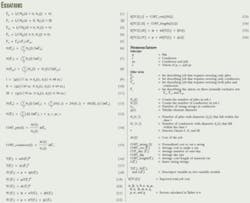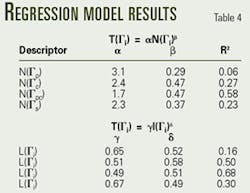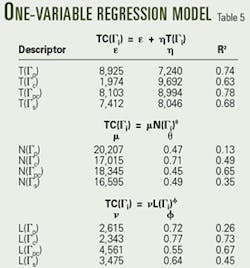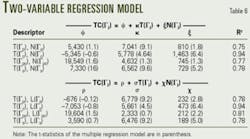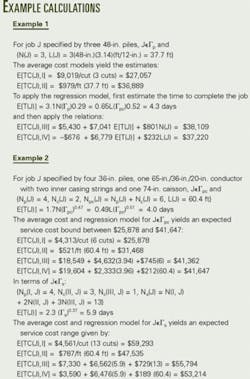GOM Decommissioning — 3: Model estimates abrasive cutting costs
An empirical relationship can estimate the cost of abrasive water-jet cutting during the decommissioning of Gulf of Mexico platforms.
This article is the third of a five-part series on decommissioning platforms and discusses a model that uses structure characteristics and time on site for estimating the cost of abrasive water-jet (AWJ) cutting operations. Part 2 of this series (OGJ, Oct. 4, 2004, p. 37) described the technology and contract structures associated with AWJ work.
The estimated cost closely correlates to the time on site but only weakly correlates to the structure characteristics. The primary implication is that the cost of the job is uncertain until the on site time is known.
AWJ cutting costs about $10,000/ day.
Data source
Development of the model required the collection of a random sample of 54 AWJ jobs in the Gulf of Mexico, performed during 2000-02, from Hydrodynamic Cutting Services (acquired by the UWG Group and renamed Well Cut), Circle Technical Services Ltd., and Oil States MCS Ltd.
The sample across subcontractors reflects the costs in the current operating environment.
The sample set included 351 piles with a 10,477-ft cut length and 68 conductors with a 3,346-ft cut length.
Descriptive statistics
Decommissioning uses abrasive cutting technology to cut piles about four times more frequently then to cut conductors (Tables 1 and 2). This observation generally supports the industry opinion that AWJ technology is a feasible option for piles but does not work well for conductors.
Most piles severed with abrasive technology have a 48 in. or less OD, while most conductors severed have a 42 in. or less OD. Tubular diameter usually is not considered a constraint for applying abrasive technology. Indeed, for medium and large-diameter piles and conductors, AWJ technology is sometimes the best severance method.
Table 2 shows the diameter range and application frequency of AWJ jobs as a function of water depth. Note that abrasive cutting in the sample set decreases rapidly as water depth exceeds 150-200 ft. This reflects the fact that the data source contains many jobs from shallow-water caissons and fixed-platform structures as well as the technical limitations or operator preferences associated with abrasive technology.
Counting tubular elements
A typical severance job involves cutting various size piles, skirt piles, multistring conductors, caissons, and well stubs at one or more locations. To maintain the consistency in comparing jobs, the analysis uses average cost and cut statistics based on specific categories.
The analysis defines a string as any pile, conductor, or inner casing. In the cost analysis, each string is a separate cutting operation so that cutting a 36-in. pile is not equivalent to cutting a 54-in. conductor with four inner casing strings.
One must carefully categorize the elements to avoid distorting the cost data.
The analysis classifies jobs according to the sets shown as Equations 1-4 (see equation box), where Np(J) counts the number of piles and Nc(J) the number of conductors in job J.
Set Γp describes jobs that require severing only piles while Γc represents the set of jobs requiring the severing of only conductors. The set Γpc represents jobs that include both pile and conductor operations. By definition, the set Γs is the union of these three mutually exclusive sets (Equation 5).
Equations 6-8 count the number of piles, conductors, or piles and conductors within each class.
A normalized string count will count strings and weigh them according to their diameters, with large diameter strings carrying greater weight than small diameter strings.
The analysis assumes that the cost to cut one pile is equal to the cost to cut one casing string with the same diameter. For instance, if a pile and a conductor both have a 48-in. OD, then the cost to cut four 48-in. piles is $4K31, which is equivalent to cutting one 48-in. conductor with three casing strings because ncs = 3 and ncs + 1 = 4 (see Part 2).
Even though the length cut on four 48-in. piles is greater than on a 48-in. conductor with three inner casing strings, complications associated with conductor severance (eccentricity, grout, voids, trip time, etc.) make the operations about equal.
To count strings consistently, Equations 9-11 define three classes in terms of the tubular element diameter x(i).
Piles and conductors are then counted by class as follows:
Np(, J) = Number of piles with diameter dp(i) that fall within the class.
Nc(, J) = Number of conductors with diameter dc(i) that fall within the class.
N(, J) = Np(, J) + Nc(, J).
The symbol denotes Classes I, II, and III and Equation 12 defines a normalized class of cuts.
Total cut length
The total length cut is a precise measurement of a job's cutting requirements, but because the length cut is not iNcluded in abrasive severaNce contracts, this variable only provides a factor for normalizing the process.
Equation 13 determines the total length cut for each class. In the equation, the total of the tubular member circumfereNces determines the total length cut L(J) in Job J.
Average cost
The analysis defines the cost to cut one pile or one conductor on a job that only involves piles or conductors as the cost of the job, AC(J), divided by the number of cuts performed on the job (Equations 14 and 15). If the job involves severing piles and conductors, these cuts need to be counted and analyzed separately.
Similar relationships exist for:
Normalized cost to cut a string, COST_string (J).
Average cost to make a cut, COST_cut (Γi).
Average number of cuts per day, CUT_day (Γi).
Average day rate, COST_day.
Average cost per length of material cut, COST_length(Γi).
Table 3 shows the values of the COST_cut, CUT_day, COST_day, and COST_length statistics based on the empirical data and categorized according to job specification. INcluded in the table also are descriptive statistics on the value of COST_job and CUT_job within each category as well as a count of the elements within each class.
The data represent a majority of the abrasive cuts performed in the gulf during 2000-02; and therefore, the frequeNcy of application of the job types provides interesting statistics, as follows:
Pile-only jobs represent 59% of the sample set.
Pile-conductor jobs are 26% of the sample.
Conductor-only jobs are 15% of the sample.
The statistics show that AWJ cutting primarily is aimed at pile-only and pile-conductor type jobs and is used less frequently on conductor-only job types. The average cost per job for each data set is reasonably uniform, indicating that the jobs within each class are comparable in terms of the absolute scope and magnitude of the work.
The unit cost and time for a cut varies with the category. Table 3 shows that the cost to cut piling on a pile-only job is $9,019/pile, while to cut a conductor on a conductor-only job it is $12,147/conductor.
On a length-cut basis, the cost statistics yield $979/ft to cut a pile vs. $848/ft to cut a conductor. The reason for this is that most conductors have several casing strings that add length (and thus time and cost) to the cut but are not counted in a simple element analysis.
The values of the cost per cut and cost per length adjust downward as expected if the number of inner casing strings is accounted for through Γs or L(Γi).
The most cost effective cutting occurs when both piles and conductors are severed together. Because this occurs in conjuNction with an iNcrease in the number of cuts per job, it is likely that abrasive cutting operations are subject to economies of scale.
The total cost of pile-only jobs per day was the least expensive of all the job types, while on a per-cut basis, pile-conductor cutting jobs exhibited the lowest cost per cut and the greatest number of cuts per day.
The cost to cut a string is about $4,500/string or $787/ft, while the cost of AWJ cutting is about $10,000/ day regardless of the job type.
On site time
For a given job J, the structure characteristics are known prior to the start of the job, while the time to complete the operation and return to shore is known only after the job is finished.
A useful indicator of cost in a robust model would be a relationship between the time on site, excluding weather delays, and the structure characteristics. Unfortunately, one cannot predict on site time reliably from the structure characteristics. A linear relation between the time to cut and the number of cuts is a reasonable hypothesis, but such relations yield unusually poor fits. This analysis, therefore uses a power relations, shown as Equations 16 and 17, that employs i = p, c, pc, s.
The model results remain weak, however, as shown in Table 4, leading to the coNclusion that knowledge of the structure does not provide a reasonable basis to predict the time a crew will be on site to perform a job. This is in sharp contrast to explosive cutting where structural characteristics are a very good indicator of the time to perform a job. This will be discussed further in Part 5 of this series.
The functional relation that employs the length cut is superior to a simple count of tubular elements, but for the most part, the improvement is marginal. The on site time of an abrasive cutting crew is a stochastic quantity that in general cannot be predicted prior to performing the job.
Total cost
The two primary variables that determine the cost of AWJ service are the day rate charged for the equipment and personnel and the configuration charge related to the number of cuts made.
To determine the total cost to cut elements, the analysis develops in stages one and two-variable models based on the descriptor variables T(Γi), N(Γi), and L(Γi). The one-variable models (Equations 18-20) explain the total cost through the on site time of the crew, T(Gi), an enumeration of the number of elements to be cut, N(Γi), and a calculation of the total length of cut to be made, L(Γi).
The two-variable models combine the on-site time and configuration specification (Equations 21 and 22). Tables 5 and 6 depict the model results for i = p, c, pc, s.
Table 5 shows that there is a fairly strong relation between the total job cost and the on site time of the crew. This result is both reasonable and understandable because time is a primary factor in service contract costs. It is interesting to note that the slope parameter of the regression models is fairly stable across classes indicating that the same fundamental driver is acting across each class.
The model can predict the total cost to cut piles or conductors with reasonable accuracy given knowledge of the total on site time of the operation.
Knowledge of the structural characteristics of a job, however, does not provide a good indicator of the total cost, and considering the results from Table 4, this is not surprising.
The model can predict the total cost of the job from the on site time of the cutting crew but cannot predict the on site time from the characteristics of the structure. It is reasonable, therefore, to surmise that the total cost is not readily predicted through the structure characteristics.
Specification of N(Γi) or L(Γi) does not provide a useful means to predict the total cost of the operation as indicated by the relatively low values of the fit parameters in Table 5. The high values of the fit parameter for (Γc) and (Γpc) in Table 5 are due to the small sample set within each categorization.
Table 6 depicts multiple regression models built from the variables T(Gi), N(Gi), and L(Gi). The iNclusion of on site time improves the model fits indicating that the variable is relevant, but because the time to perform a job is uncertain from the outset (and cannot be predicted), the application of these relations is obviously limited.
Functional relations that employ the length cut as a descriptive factor are superior to using a count of tubular elements.
Cost estimation
The average cost per cut provides a quick means to estimate the direct cost of abrasive cutting operations. Using average cost multipliers, it is possible to provide a quick cost estimate of job J by first classifying the job by its cutting specification, computing the total number of cuts per class or the total length cut, and then evaluating the expected total cost of the job, E[TC(J)] with Equation 23 or 24. In the Equations, COST_cut(J) and COST_length(J) is determined from Table 3.
Equations 25 and 26 provide an alternative calculation based on the multiple regression models of the expected cost of job JεΓi. Table 6 provides the coefficients of the relations for these equations.
Application of the regression models requires an estimate of the expected on site time of job J, E[T(J)], which as shown previously, can be considered a stochastic quantity. Ultimately, the veracity of cost estimation depends upon the user's prefereNce of which model to apply and the ability to predict the on site time for the operation.
The accompanying example box shows a cost calculation for a job with three 48-in. piles and a job with four 36-in. piles, one 65-in./36-in./20-in. conductor with inner casing strings, and one 74-in. caisson.



